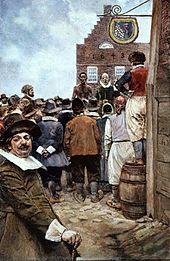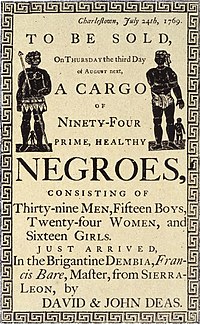
A | B | C | D | E | F | G | H | CH | I | J | K | L | M | N | O | P | Q | R | S | T | U | V | W | X | Y | Z | 0 | 1 | 2 | 3 | 4 | 5 | 6 | 7 | 8 | 9
 Proportion of Black Americans in each county as of the 2020 U.S. census | |
| Total population | |
|---|---|
| 46,936,733 (2020)[1] 14.2% of the total U.S. population (2020)[1] 41,104,200 (2020) (one race)[1] 12.4% of the total U.S. population (2020)[1] | |
| Regions with significant populations | |
| Across the United States, especially in the South and urban areas | |
| Languages | |
| English (American English dialects, African-American English) Gullah Creole English | |
| Religion | |
| Predominantly Protestant (71%) including Historically Black Protestant (53%), Evangelical Protestant (14%), and Mainline Protestant (4%); significant[note 1] others include Catholic (5%), Jehovah's Witnesses (2%), Muslim (2%), and unaffiliated (18%).[2] |
| Part of a series on |
| African Americans |
|---|
African Americans, also known as Black Americans or Afro-Americans, are an ethnic group consisting of Americans with partial or total ancestry from any of the Black racial groups of Africa.[3][4] African Americans constitute the third largest racial or ethnic group in the U.S. after White Americans and Hispanic and Latino Americans.[5] The term "African American" generally denotes descendants of Africans enslaved in the United States.[6][7]
Most African Americans are descendants of enslaved people within the boundaries of the present United States.[8][9] While some Black immigrants or their children may also come to identify as African American, the majority of first-generation immigrants do not, preferring to identify with their nation of origin.[10] Most African Americans are of West African and coastal Central African ancestry, with varying amounts of Western European and Native American ancestry.[11]
African-American history began in the 16th century, with Africans from West Africa and coastal Central Africa being sold to European slave traders and transported across the Atlantic to the Western Hemisphere. After arriving in the Americas, they were sold as slaves to European colonists and put to work on plantations, particularly in the southern colonies. A few were able to achieve freedom through manumission or escape and founded independent communities before and during the American Revolution. After the United States was founded in 1783, most Black people continued to be enslaved, being most concentrated in the American South, with four million enslaved only liberated during and at the end of the Civil War in 1865.[12] During Reconstruction, they gained citizenship and adult-males the right to vote; due to the widespread policy and ideology of White supremacy, they were largely treated as second-class citizens and found themselves soon disenfranchised in the South. These circumstances changed due to participation in the military conflicts of the United States, substantial migration out of the South, the elimination of legal racial segregation, and the civil rights movement which sought political and social freedom. However, racism against African Americans remains a problem into the 21st century. In 2008, Barack Obama became the first, and so far only African American to be elected president of the United States.[13]
African-American culture has had a significant influence on worldwide culture, making numerous contributions to visual arts, literature, the English language, philosophy, politics, cuisine, sports, and music. The African-American contributions to popular music is so profound that most American music, including jazz, gospel, blues, rock and roll, funk, disco, hip hop, R&B and soul, has its origins either partially or entirely in the African-American community.[14][15]
History
Colonial era
The vast majority of those who were enslaved and transported in the transatlantic slave trade were people from several Central and West Africa ethnic groups, who had been captured directly by the slave traders in coastal raids,[16] or sold by other West Africans, or by half-European "merchant princes"[17] to European slave traders, who brought them to the Americas.[18]
The first African slaves arrived via Santo Domingo to the San Miguel de Gualdape colony (most likely located in the Winyah Bay area of present-day South Carolina), founded by Spanish explorer Lucas Vázquez de Ayllón in 1526.[19] The ill-fated colony was almost immediately disrupted by a fight over leadership, during which the slaves revolted and fled the colony to seek refuge among local Native Americans. De Ayllón and many of the colonists died shortly afterward of an epidemic and the colony was abandoned. The settlers and the slaves who had not escaped returned to Haiti, whence they had come.[19]
The marriage between Luisa de Abrego, a free Black domestic servant from Seville, and Miguel Rodríguez, a White Segovian conquistador in 1565 in St. Augustine (Spanish Florida), is the first known and recorded Christian marriage anywhere in what is now the continental United States.[20]

The first recorded Africans in English America (including most of the future United States) were "20 and odd negroes" who came to Jamestown, Virginia via Cape Comfort in August 1619 as indentured servants.[21] As many Virginian settlers began to die from harsh conditions, more and more Africans were brought to work as laborers.[22]

An indentured servant (who could be White or Black) would work for several years (usually four to seven) without wages. The status of indentured servants in early Virginia and Maryland was similar to slavery. Servants could be bought, sold, or leased and they could be physically beaten for disobedience or running away. Unlike slaves, they were freed after their term of service expired or was bought out, their children did not inherit their status, and on their release from contract they received "a year's provision of corn, double apparel, tools necessary", and a small cash payment called "freedom dues".[24] Africans could legally raise crops and cattle to purchase their freedom.[25] They raised families, married other Africans and sometimes intermarried with Native Americans or European settlers.[26]
By the 1640s and 1650s, several African families owned farms around Jamestown and some became wealthy by colonial standards and purchased indentured servants of their own. In 1640, the Virginia General Court recorded the earliest documentation of lifetime slavery when they sentenced John Punch, a Negro, to lifetime servitude under his master Hugh Gwyn for running away.[27][28]

In the Spanish Florida some Spanish married or had unions with Pensacola, Creek or African women, both slave and free, and their descendants created a mixed-race population of mestizos and mulattos. The Spanish encouraged slaves from the colony of Georgia to come to Florida as a refuge, promising freedom in exchange for conversion to Catholicism. King Charles II issued a royal proclamation freeing all slaves who fled to Spanish Florida and accepted conversion and baptism. Most went to the area around St. Augustine, but escaped slaves also reached Pensacola. St. Augustine had mustered an all-Black militia unit defending Spanish Florida as early as 1683.[29]
One of the Dutch African arrivals, Anthony Johnson, would later own one of the first Black "slaves", John Casor, resulting from the court ruling of a civil case.[30][31]
The popular conception of a race-based slave system did not fully develop until the 18th century. The Dutch West India Company introduced slavery in 1625 with the importation of eleven Black slaves into New Amsterdam (present-day New York City). All the colony's slaves, however, were freed upon its surrender to the English.[32]
Massachusetts was the first English colony to legally recognize slavery in 1641. In 1662, Virginia passed a law that children of enslaved women took the status of the mother, rather than that of the father, as under common law. This legal principle was called partus sequitur ventrum.[33][34]
Zdroj:https://en.wikipedia.org?pojem=African_American
Text je dostupný za podmienok Creative Commons Attribution/Share-Alike License 3.0 Unported; prípadne za ďalších podmienok. Podrobnejšie informácie nájdete na stránke Podmienky použitia.
Antropológia
Aplikované vedy
Bibliometria
Dejiny vedy
Encyklopédie
Filozofia vedy
Forenzné vedy
Humanitné vedy
Knižničná veda
Kryogenika
Kryptológia
Kulturológia
Literárna veda
Medzidisciplinárne oblasti
Metódy kvantitatívnej analýzy
Metavedy
Metodika
Text je dostupný za podmienok Creative
Commons Attribution/Share-Alike License 3.0 Unported; prípadne za ďalších
podmienok.
Podrobnejšie informácie nájdete na stránke Podmienky
použitia.
www.astronomia.sk | www.biologia.sk | www.botanika.sk | www.dejiny.sk | www.economy.sk | www.elektrotechnika.sk | www.estetika.sk | www.farmakologia.sk | www.filozofia.sk | Fyzika | www.futurologia.sk | www.genetika.sk | www.chemia.sk | www.lingvistika.sk | www.politologia.sk | www.psychologia.sk | www.sexuologia.sk | www.sociologia.sk | www.veda.sk I www.zoologia.sk
